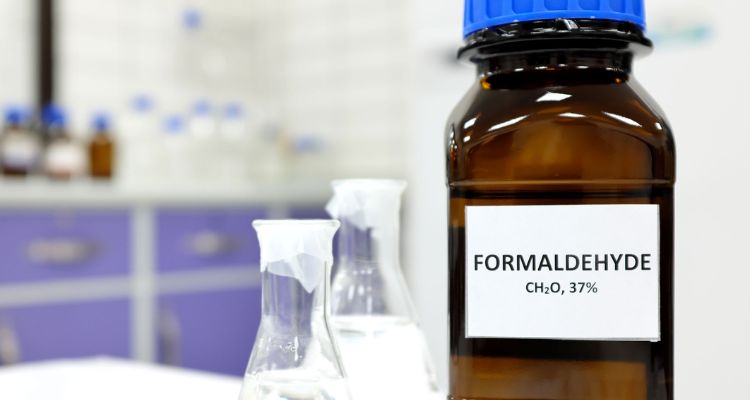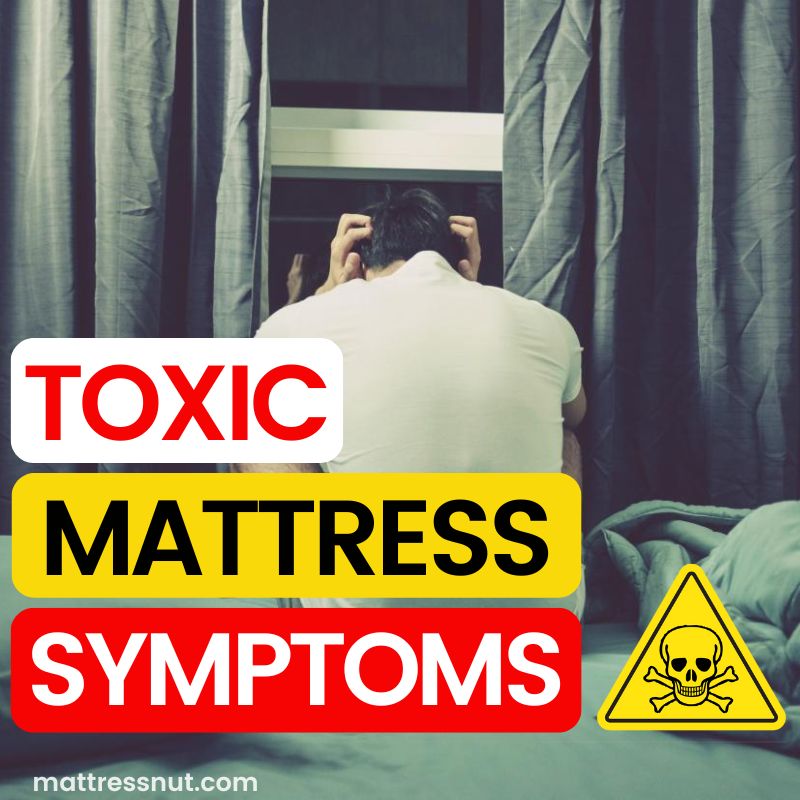On average, a person spends 6-8 hours on his bed mattress. These mattresses, mainly memory foam, may contain harmful chemicals like isocyanates, formaldehyde, benzene, etc. These chemicals are widely used in manufacturing rigid mattress foams, fibers, coatings, varnish paints, and even the automobile industry’s production and repair processes.
Many health risks are with their use, especially in mattresses, which could be alarming and worrying for us.
What Makes a Mattress Toxic?
It needs to be kept in mind and understood about what makes our mattresses toxic regardless of whatever brand they are off. Releasing a minute amount of gaseous chemicals like volatile organic compounds VOCs can be another cause. However, polyurethane with other flame retardants and plastic-based chemicals are the leading cause of this issue.
Below are some of these chemicals to avoid in a mattress that can make them toxic to human health (also check 10 amazing organic cotton mattresses).
Formaldehyde

Formaldehyde is a strong-smelling and colorless gas mainly to manufacture building and household materials products. People are exposed to this chemical primarily through inhaling it, whereas its liquid primarily goes through the skin inside your body. In most cases, the body produces formaldehyde. Enzyme proteins break down formaldehyde in our bodies to create formate (formic acid), which can break down further to form carbon dioxide (CO2).
Formaldehyde works as a preservative used adhesively in mattress production. According to the Environmental protection agency, this chemical is mainly responsible for nose, throat, and skin irritation. It can increase the risk of coughing and wheezing, asthma, and allergies if not dealt with promptly. These chemicals break down in the air within hours and can easily dissolve in water.
Isocyanates
Memory foam mattresses contain TDI (Toluene Di-Isocyanate), an isocyanate with a strong odor that permeates through the bed and into the air over time. These compounds in mattresses emit hydrocarbons into the air we breathe throughout the mattress’s lifespan.
Polyurethane in memory foam mattress production is a mixture of polyols and diisocyanates. They are for making crude petroleum oil. The reaction of these chemicals with hydroxyl groups (mostly alcohol-based) can form polyurethane polymers and components of polyurethane foams, synthetic fiber, and PU paints. Every polyurethane foam product is made with a raw ingredient; isocyanates.
Manufacturers claim that the reaction of isocyanates and polyols in mattresses is no longer volatile. Polyurethane in the production of synthetic foams releases volatile chemical isocyanates. However, older polyurethane mattresses break into dust and are very bad for off-gassing (also check the top rated mattresses without memory foam).
Benzene
Benzene is another harmful chemical in the production of some memory foam. It is the foam production process that can actively affect the eyes and mucus membrane due to long exposures. Benzene is among the few hazardous chemicals that can cause cancer, infertility, and even brain development disorders. In addition, any off-gassing leads to direct breathing of these harmful chemicals causing severe health issues.
An Annual Review of Public Health study has shown that this chemical used in conventional mattress making can even increase the risks of acute myeloid leukemia and other diseases. Chemicals in non-organic mattresses such as benzene, formaldehyde, and other flame retardants are highly hazardous to sensitive people.
These chemicals link to cancer-creating properties in humans with direct contact with them for a long. The US CPSC has even banned some products due to these chemicals, including benzene, as they can inflict severe damage to health.
This chemical can even make your cells not work correctly. It can damage the immune system and even cause anemia due to the lack of red cells in the bone marrow. Therefore, considering this chemical’s severe overall health danger, benzene should be well studied in a mattress before buying one.
Acetone
Acetone is a compound chemical perilous for human interactions or use. A highly flammable and volatile chemical and colorless with a pungent odor. Acetone is widely used as a solvent for mattress foams structure to be more homogenous. Besides its strong smell, it can irritate your eyes and skin. Therefore, using this chemical during the production process is highly dangerous.
Long-time exposure to this chemical, even in small concentrations, is hazardous to human health even though a small quantity of this chemical used for a certain period is considered safe.
However, as in mattresses, acetone can be extremely dangerous in large quantities with a longer duration. It can cause dryness and redness and irritate your skin with other health problems. The other health problems with this chemical are nausea, headaches, confusion, the size and amount of blood cells changes, passing out, and even coma.
Fiberglass
For fire protection in mattresses, this is a good option as a fire barrier. The reason it’s used in the bed because it shields around it by melting but does not release harmful chemicals. It encases the mattress, thus preventing it from catching any fire. Many inexpensive and modern beds coat with this fiberglass around their foam layers, providing cheap and chemical-free protection.
As a con, fiberglass strands escape from the mattress fibers when this mattress starts to wear out (also check 10 great mattresses without fiberglass). If you accidentally rub your skin against fiberglass can cause significant itch, discomfort, and minor wounds.
Polybrominated Diphenyl Ethers
Polybrominated diphenyl ethers, eminent as flame retardant chemicals, are widely used in many household products. This chemical includes electrical, textile, coatings, and polyurethane foams. For example, all mattresses must contain enough chemical flame retardants to withstand at least a 2-foot wide open flame for 70 seconds. Most significant sleep product companies use cheap or low-quality flame retardants to cut the cost of production.
Polybrominated diphenyl ethers are volatile compounds. They have an unstable structure, which evaporates into the air and dust inside your mattress. This chemical compound can only enter your body through dermal absorption when lying on the bed. Therefore, it will start to accumulate in your body and will begin to cause serious health effects.
What Are the Symptoms of Sleeping on Toxic Mattresses?
Headaches, Muscle Pain

People who sleep on polyurethane, memory foam, or synthetic foams are more likely to have headaches or migraines. These pains are due to off-gassing and the VOC chemical that emits from these mattresses. This even causes muscle pains of not providing an adequate amount of sleep and back and spinal alignment.
Frequent Nausea
VOCs in memory foam mattresses usually cause many issues like headaches, dizziness, and nausea. Nausea is commonly due to off-gassing due to different toxic chemicals.
Lack Of Concentration
A poor-quality mattress manufactured with harmful and toxic materials will lead to poor sleep and a lack of concentration. With not getting enough sleep, your mind can tire and cause dizziness and lack of attention.
Itchy/Sore Throat
A harmful and toxic mattress that contains VOCs can easily cause severe allergies to people prone to it. These allergies can cause Itchy and sore throat, leading to upper throat or sinuses cancers. Therefore, always use hypoallergenic mattresses for good airflow and breathability.
Skin, Nose, And Eye Irritation
Skin, nose, and eye irritation problems arise from using VOC chemical-made products, especially mattresses. However, among many, butadiene is a common chemical that can cause skin, nasal passage, lungs, and even throat irritations or cancers.
Chest Tightness
Rigid foam mattresses produce using harmful chemicals are usually quite firm. These mattresses don’t support your body, especially the upper part, to sink in the bed for proper support. All mattresses should provide adequate pressure to the chest; otherwise, it can lead to chest congestion, tightness, or even asthma.
Difficulty Breathing
When a mattress does not support your body fully, especially the upper part, it can lead to chest tightness or congestion. If not taken care of, this condition can make it difficult for anyone to breathe.
How To Protect Yourself from Mattress Chemicals?
To protect yourself from new mattress chemicals, always reduce the Volatile Organic Compounds (VOCs) from your mattress, reducing exposure to off-gassing. Many conventional mattresses contain polyurethane, polyester, formaldehyde, etc., based on synthetic fabrics and chemicals considered extremely dangerous for human health. So, check the different certification levels of the mattress you are buying.
Look for a Global organic textile standard GOTS-certified mattress. Then, you can check if that mattress is Greenguard Gold certified for extra protection. This certification will guarantee that the chemicals used are of low emissions.
What Is the Healthiest Type of Mattress?
A study shows that 100% organic foam mattresses have antimicrobial properties, making them resistant to mold, allergens, and dust mites. These mattresses are for people with allergies due to their breathable, hypoallergenic features.
In addition, these mattresses are good at wicking away moisture to keep you cool throughout the night’s sleep. People with side, back, or neck pain can get relief from these mattresses (check 8 amazing organic cotton mattresses).
Toxic Mattress Symptoms: Understanding the Dangers
On average, a person spends 6-8 hours on his bed mattress. Surprisingly, these mattresses, especially those made of memory foam, might be packed with harmful chemicals. While they serve their purpose in manufacturing, they can have detrimental health effects for those who sleep on them.
What Makes a Mattress Toxic?
It’s essential to realize that not all mattresses are made equal. Some release harmful gaseous chemicals, such as volatile organic compounds (VOCs), primarily due to polyurethane combined with other flame retardants and plastic-based chemicals.
Key Chemicals in Mattresses
When we dive deeper, there are certain chemicals, like formaldehyde, isocyanates, benzene, and acetone, which are prevalent in many mattresses. While they serve industrial purposes, their extended exposure has been linked to various health issues.
Signs of Sleeping on a Toxic Mattress
If you’ve ever woken up with headaches, muscle pain, or even a sore throat, your mattress might be to blame. These symptoms, along with nausea, lack of concentration, skin irritation, and even breathing difficulties, can be linked to the chemicals present in non-organic mattresses.
Shielding Yourself from Mattress Chemicals
It’s not all doom and gloom. By being proactive, you can significantly reduce your exposure to these harmful chemicals. Always check for certifications like the Global Organic Textile Standard (GOTS) when purchasing a mattress. Such certifications are an assurance that the product has low chemical emissions.
Choosing the Healthiest Mattress
For those concerned about their health, 100% organic foam mattresses are the way to go. These mattresses not only resist allergens but also provide relief for those with back or neck pain.
Conclusion
We believe the above study must have helped to explain the severe health factors associated with different foam mattresses that use VOCs and other hazardous chemicals. Since these chemicals have severe general health issues, especially for people with sensitive health or skin.
Body and muscle pain, chest tightness, skin, throat, nose irritations, or even cancers are the potential health outcomes of these chemical products. Considering these issues, health experts and many doctors strongly advise checking the quality of mattresses before purchase.

